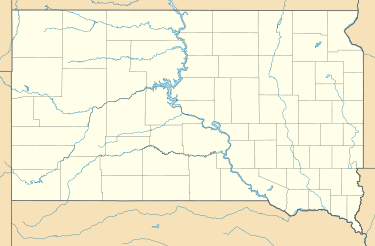Titan Wind Project
| Titan Wind Project | |
|---|---|
 Location of Titan Wind Project in South Dakota | |
| Country | United States |
| Location | Hand County, South Dakota |
| Coordinates | 44°30′58″N 99°12′6″W / 44.51611°N 99.20167°WCoordinates: 44°30′58″N 99°12′6″W / 44.51611°N 99.20167°W |
| Status | Phase I operating |
| Commission date | Phase I: 2009 |
| Owner(s) | BP Wind Energy[1] |
| Power generation | |
| Units operational | 10 Liberty Wind Turbines, @2.5 MW |
| Nameplate capacity | Phase I: 25 MW |
The Titan Wind Project is 25MW wind farm with a proposed expansion to 5,050 MW, formerly known as Rolling Thunder, based in South Dakota. The project developers, Clipper Windpower and BP Alternative Energy, expect to build Titan in several phases and, when completed, it will be one of the largest wind farms in the world.[2][3][4]
The complete wind farm would use up to 2,020 of Clipper's Liberty 2.5 MW wind turbines.[2] However, this is unlikely, as Clipper Windpower has since ceased production of wind turbines due to financial problems.
Production
Operating at full capacity, the project would be able to supply the electricity for 100% of the households in the state several times over. South Dakota's entire electricity consumption in 2005 was 9.811 TWh.[5] At an assumed capacity factor of 40% (roughly what is currently observed in windy South Dakota), a 5.05 GW nameplate capacity would correspond to an annual generation of:
(5.05 GW) × (0.40) × (365 days/year) × (24 hours/day) × (1 TWh/1000 GWh) = 17.7 TWh
Phase I
Construction of phase I began in 2009 on a 7,500-acre (3,000 ha) site in Hand County in the Ree Hills south of Ree Heights.[1] The project was complete by the end of the year.[6] Phase I consists of 10 Liberty C89 2.5 MW wind turbines for a combined nameplate capacity of 25 MW. Northwestern Energy has a long-term power purchase agreement.[1][6]
Renewable Energy Objective
In 2008, the South Dakota legislature passed a Renewable Energy Objective. The bill is mostly a symbolic gesture, as it's not a mandate, only an objective. Furthermore, the objective is only 10% by 2015. Considering that hydroelectric dams already produce about 45% of the state's electricity, that objective will likely be met.[7][8]
See also
References
- 1 2 3 "BP Ramps Up to Full Construction of First Phase of Wind Farm in South Dakota". BP Alternative Energy. 2009-08-05. Retrieved 2010-03-16.
- 1 2 "Titan Wind Project To Produce 5,050 MW". Renewable Energy World. 2008-08-05. Retrieved 2010-03-17.
- ↑ "Clipper & BP Complete Titan Wind Turbine Deal". Renewable Energy World. 2008-12-04. Retrieved 2010-03-17.
- ↑ "Clipper Windpower and BP Alternative Energy form Joint Venture to Develop up to 5,050 MW". Clipper Windpower. 2008-07-30. Retrieved 2010-03-17.
- ↑ "Electric Power and Renewable Energy in South Dakota". USDOE, EERE. 2008-06-25. Retrieved 2010-03-15.
- 1 2 "U.S. Wind Energy Projects - South Dakota". American Wind Energy Association. 2009-12-31. Retrieved 2010-03-16.
- ↑ Renewable energy objective
- ↑ Energy Information Administration